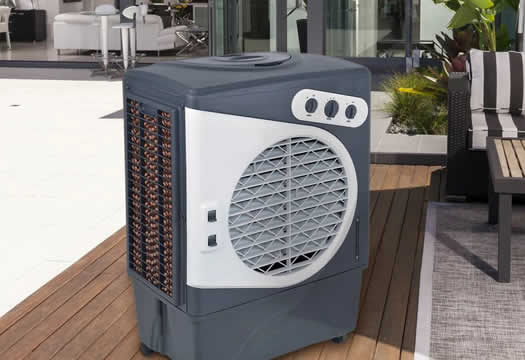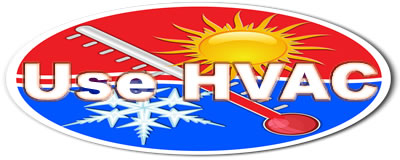Heating and Cooling
Throughout the year as the weather changes outside, we like to keep our homes and working environments at a stable, comfortable temperature.
Heating and cooling systems are many and varied, but all perform the necessary function of maintaining that consistent, agreeable temperature that enables us to live and work in comfort.
It is this subject that is the mainstay of this website and in this section I look at the different solutions that are available for performing that all-important temperature maintenance inside our living and working environments.
Heating
 During the colder, winter months of the year, the outside temperature can drop to levels that are not particularly welcoming unless you happen to be a penguin or a polar bear.
During the colder, winter months of the year, the outside temperature can drop to levels that are not particularly welcoming unless you happen to be a penguin or a polar bear.
We can't do much about the weather out there, but we certainly can do something about the temperature inside the building we occupy. Heating equipment can be installed to ensure that the internal temperature is elevated to a point that is much more comfortable for us.
The most common heating solutions in homes and work places are either the centrally managed and distributed ″central heating″ variety or individual room heaters.
Central Heating
An easily managed form of central heat, this solution comprises a centrally located furnace or heat producing unit that produces either heated air that is forced around the building through ducting, or heated water that is distributed though pipes to radiators located in each room.
The forced air variety generally has a furnace that is powered by solid fuel, oil or gas (natural gas or propane) and the hot air is transported through the ductwork by a network of fans. This has the advantage that the air outlets in individual rooms are often inconspicuously installed in walls or baseboards.
The type that produces heated water that is pumped to radiators is becoming more common these days. However, there is the small disadvantage that radiators are more conspicuous and take up space in each room they are situated in.
Both types of central heating have a major advantage over other types of heating, because the heat they produce is generally also used to heat a tank of water to provide on-demand hot water for the household.
Room Heaters
A form of heating common in older buildings is the traditional fireplace where solid fuel such as coal, wood or coke is burned in an ″open fire″ that is often considered to be a welcoming visual effect as well as providing heat for the room.
The downside to open fires is the chimney needs to be cleaned regularly and they are generally the least efficient forms of heating as most of the heat produced goes straight up the chimney!
In many homes, open fireplaces have been repurposed to house gas fires that use the chimney as an outlet for unburned and noxious gases that are produced. These are generally much more efficient as the majority of the heat produced is radiated out into the room.
Other forms of room heater include unvented propane gas fueled heating units, which are very heat efficient, but require the room to be well ventilated to disperse the unwanted gases that are produced. Most notably among these gases is carbon monoxide, which can prove potentially dangerous if the gas is not vented away (for example if all windows and doors in the room are closed).
HVAC
Another common internal temperature maintenance solution that deals with both heating and cooling is the central Heating, Ventilation and Air Conditioning (HVAC) system.
This is a system that works off a centrally located combination heater and AC equipment that distributes either heat or cold air as required depending on the season. Hot or cold air is forced through ductwork to every room in the house and the internal temperature is generally regulated from a centrally and usually conveniently located thermostat.
This topic is covered in more detail in a separate article (see below).
Cooling
 During the summer months, depending on your location, the outside temperature can rise to uncomfortable levels. Fortunately, there are a number of ways that we can regulate the internal temperature of our homes or work places to counter the effects of the summer heat.
During the summer months, depending on your location, the outside temperature can rise to uncomfortable levels. Fortunately, there are a number of ways that we can regulate the internal temperature of our homes or work places to counter the effects of the summer heat.
The most common solution is to have air conditioning installed, although this can prove to be expensive in high energy consumption since electricity costs are high and rising. Other solutions to reduce the heat load on a building exist that are less expensive and I'll cover these in a dedicated article (see the list of titles at the foot of this page).
Air Conditioning
Arguably the most effective and convenient way to cool the interior of a building to a comfortable level in hot weather is air conditioning. This can take one of several forms and I'll briefly cover these below while expanding on each method in separate articles linked to below.
Central Air
Similar to the way central heat can be configured, this form of cooling uses ductwork to send forced, cooled air throughout the house.
The main advantage is that that there are no intrusively placed radiating devices in each room as just a conveniently placed vent in a wall is needed per room. Another advantage is that the temperature of the entire house is regulated from a single, central thermostat for convenience.
Zoned or Distributed Air Conditioners
There are three main types of distributed cooling device to regulate the temperature on a room-by-room basis for a home or work place. They can be fitted with a heating capability, making them convenient, all-round temperature control solutions. These are:
- Mini-split AC
- Window AC or PTAC units
- Portable AC Units
Let's look at each of these solutions.
Mini-Split Air Conditioners
These are commonly installed as an alternative cooling solution to central air. Each room is fitted with an internal unit (the compressor) that blows the cooled air into the room, while extracting the unwanted warm air and sending it to a second unit (the condenser) located outside the building.
The two main types of mini-split AC are the single zone and the multi-zone types.
The single zone type has each compressor unit connected to its own condenser unit, which is often located right outside the room.
The multi zone type has multiple compressors hooked up to one or more condenser units outside.
Window AC
A cheaper and easier to install type of cooler is the window AC unit, which installs directly into a window opening and the compressor and condenser sections are housed in the single unit.
The advantages are that they are cheaper to purchase than mini-split AC and can be installed by someone with handyman skills.
The disadvantage is that window units occupy space in a window opening and reduce the amount of natural daylight entering the room.
PTAC
The Packaged Terminal Air Conditioner (PTAC) is similar to a window AC unit in that it is a single unit housing both compressor and condenser sections with an ventilation outlet through a window or external wall vent.
This type of cooling unit is often found in hotel rooms and offices, yet is less common in homes.
Portable AC
Another popular, low cost cooling solution is the portable air conditioner. This is generally the lowest cost purchase ticket cooling solution utilizing the refrigerant-based air conditioning process.
Portable units can be sited almost anywhere as long as there is a window or external wall outlet vent available for the unit to connect its exhaust hose to allow the waste hot, moist air to be vented to the outside. They are favored by those living in rental apartments where window units are not allowed to be installed or where the occupant expects to move from place to place.
Because portable AC units do not need any permanent installation, they are perfect for people that move around from place to regularly as the units can simply be taken with them wherever they go.
Evaporative Cooling Units
 There is a low-cost cooling solution alternative to the more expensive-to-run, refrigerant-based air conditioners called the evaporative cooler (or swamp cooler).
There is a low-cost cooling solution alternative to the more expensive-to-run, refrigerant-based air conditioners called the evaporative cooler (or swamp cooler).
These coolers do not contain refrigerant-based cooling equipment, but instead use the process of the evaporation of water to produce cold air. The process typically uses 1/20th the amount of electricity that a comparable air conditioner uses, making them very economical to run.
The major disadvantage of evaporative coolers is they do not work well in humid conditions. High humidity greatly reduces the ability of the air to absorb more moisture, reducing the cooling effect of evaporation.
To enjoy the cost and environmental advantages of swamp coolers, users need to live in areas that have a hot but dry climate, such as desert locations. It is advisable to check with your local weather station to learn the local humidity levels. If they are below 50% on average, a swamp cooler will work well enough to provide a low-cost cooling solution.
This topic is also covered in a separate, more detail article (see below).
Conclusion
Many locations around the country experience the temperature changes of the seasons each year, with most experiencing cold winters and hot summers.
To combat the cold during winter time, some form of internal heating is needed. The choice of heating solution depends on your location and the availability of fuel sources and their cost.
Whether you choose to install air conditioning in one form or another or you are lucky enough to live in a dry climate that is suitable for using an evaporative cooling device, being able to cool your home or work place to a comfortable level is a great convenience.
You can read more on each subject by selecting one of the article titles listed below:
- Self Evaporating Portable Air Conditioner
- Ventless Air Conditioner
- Self Contained Air Conditioners
- How the Auto Evaporation Function on an Air Conditioner Works
- Which Portable Air Conditioners Don't Need to be Drained
- Portable Air Conditioners: Single Hose vs Dual Hose
- Air Conditioning Systems: The Different Types Explained
- A Cool Home
- Keeping Cool in Summer
